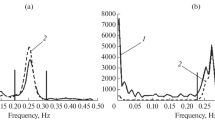Abstract
A statistical analysis was made of long continuous records of RB intervals of the ECG of 64 patients with pyogenic surgical infections. The following indices were examined: the mean RR interval\((\overline {RR} )\), standard deviation (σ), range of variation (V), first and third correlation coefficients, excess, asymmetry,\(\overline {RR} /\sigma \) ratio, and the form of the autoregression cluster. In three groups of patients differing in the severity of their condition, the values of σ,\(\overline {RR} /\sigma \), and V were found to differ statistically significantly. These differences were clearly reflected in the size and shape of the autoregression cluster. The results suggest that the statistical chracteristics of long records of the cardiac rhythm can be used for the objective assessment of the severity of the patient's condition and the efficacy of his treatment.
Similar content being viewed by others
Literature Cited
R. M. Baevskii, Yu. N. Volkov, and I. G. Nidekker, in: Statistical Methods of Analysis of the Cardiac Rhythm [in Russian], Moscow (1968), pp. 51–61.
Yu. V. Beletskii, in: Advances in the Clinical Management, Diagnosis, and Treatment of Diseases of the Internal Organs [in Russian], Moscow (1968), pp. 28–30.
Yu. N. Volkov, “Principles of automatic operative medical control and their realization in resuscitation practice”, Author's Abstract of Doctoral Dissertation, Leningrad (1975).
A. D. Voskresenskii and M. D. Venttsel', Statistical Analysis of the Cardiac Rhythm and Hemodynamic Indices in Physiological Research [in Russian], Moscow (1974).
E. Grinene, Teor. Prakt. Fiz. Kul't. No. 8, 26 (1974).
D. M. Zhemaitite, “Possibility of the clinical use and automatic analysis of rhythmograms”, Doctoral Disseration, Kaunas (1972).
V. M. Zatsiorskii and S. K. Sarsaniya, in: Mathematical Models of Analysis of the Cardiac Rhythm [in Russian], Moscow (1968), pp. 31–49.
V. N. Zvyagintsev et al., in: Statistical Electrophysiology [in Russian], Part 2, Vilnius (1968), pp. 206–216.
M. I. Kuzin, E. A. Bogdanova, and E. M. Kuterman, in: The Theory and Practice of Automation of Electrocardiological Investigations [in Russian], Pushchino-on-Oka (1973), p. 57.
M. ten Hoopen and J. P. Bongaarts, Cardiovasc. Res.,3, 218 (1969).
M. I. Kuzin (M. J. Kuzin), V. D. Jukovsky, E. M. Kuterman, et al., in: First World Conference of Medical Informatics. Proceedings, Vol. 2, Amsterdam (1974), pp. 777–779.
H. Luczak and W. Laurig, Ergonomics,16, 85 (1973).
G. Mulder et al., Ergonomics,16, 69 (1973).
V. McA. Sayers, Ergonomics,16, 17 (1973).
Rights and permissions
About this article
Cite this article
Shargorodskaya, D.V., Nidekker, I.G., Tsukerman, B.M. et al. Significance of statistical characteristics of the sinus rhythm of the heart. Bull Exp Biol Med 84, 1659–1661 (1977). https://doi.org/10.1007/BF00801711
Received:
Issue Date:
DOI: https://doi.org/10.1007/BF00801711




